Hollywood smile
Hollywood smile refers to a complete make-over of the smile and applies to placing dental crowns on all teeth or at least on the visible teeth on both upper and lower jaw, which is at least from fives to fives. Hollywood smile can be also achieved by placing dental facets, but since placing dental crowns is more commonly required, we will focus on dental crowns (caps) in the further text.
The name Hollywood smile was introduced in the USA and refers to using the colour white or BLEACH for making dental crowns. The colour can be achieved only by placing non-metal crowns, because the bright white teeth are not possible to obtain using the metal, grey base
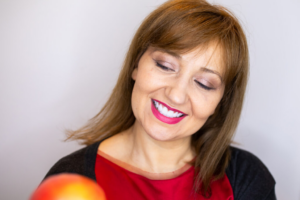
The colour BLEACH is graded from 1 – 4, where 1 refers to the lightest white, while 4 refers to the darkest white. In the daylight, the differences are hardly visible.
Mainly, our foreign patients require the precise and accurate offer and procedure plan, without having to come to the practice for a visit. In that case, it is enough to send the photographs of the teeth and the smile, as well as the Ortopan recording, if possible. After the analysis, most arrangments can be made over the phone.
When the patient comes to the first visit, before starting making the crowns, the dentist has do do a DSD protocol first. The patient and the dentist together decide on the desireable shape, position and colour of the definite teeth.
Hollywood smile often requires an extensive dental work, and beside crowns, it is usually needed to make dental bridges. This procedure exeeds the office conditions – using Cerec to make dental crowns, the procedure is continued in the laboratory where CAD CAM systems are used for making non’metal crowns.
In order to simplify the procedure and shorten the time our foreign patients need to spend in Serbia, we have made a special concept:
The first visit takes one whole day. During the visit, according to the arrangement, all teeth are shaped (trimmed) and immediately, temporary crowns are made. That day, the patient can go home in the afternoon. This phase is performed with the local anesthetic.
After shaping the patient does not need to visit the practice, except in cases of complications such as: toothache, falling off or cracks on the temporary crowns.
During the time the patient has temporary crowns, it is usual and expected to feel pain and sensitivity to hot/cold from time to time. Temporary crowns cannot fit as precisely as permanent ones.
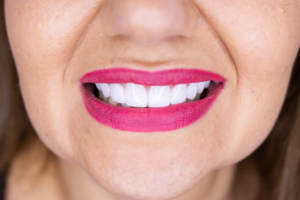
During the first few days, the patient can have a mild swelling and a local decrease of the immunity, due to the long lasting-dental intervention, which is also common.
To avoid potential complications or minimize them, we take care that every single tooth is checked on the day the teeth are shaped.
Some patients, due to their obligations, cannot come to the practice for a final check for one or two months, so this is a very important phase in the procedure.
After three days, or a little longer, the patient should visit the practice again for a check and cementing of the crowns. Sometimes, the patient needs to visit the practice for an additional check, but this arrangement depends on the severity of the case.
On the first day, the patient tries the half-finished crowns. This check is the most important, so that all required corrections can be made. The corrections implying shortening or removing ceramics can be performed in the practice. If the corrections imply adding ceramics at certain places on the crowns, this is done later in the laboratory. The patient should concentrate at this check, so that we can take into consideration every aspect of the new smile and the shape of the crowns, because it is possible to make corrections in this phase.
This check-up mainly implies using a local anesthetic which can prevent the patient from the careful observation of the new crowns.
On the second day, the crowns are brought to the office from the laboratory, after all corrections and ready for cementation.
On the third day, after the cementation, the patient needs to come to the office for a control check-up, and if the patient stays in Serbia for a bit longer, this control check-up can be postponed for a few days.
Depending on the number of teeth and the severity of case, correction and cementation can be finished in one day.
Concerning the colour, crowns are usually made in the lighter shade. If the patient requires, the crown colour can always be corrected to a bit darker shade, but it is not possible to make the shade lighter during the procedure.
Dental crowns
Dental crowns or caps are an ideal solution in cases where teeth are so damaged that it is impossible to restore the missing parts of the teeth by placing a conventional filling.
These cases imply massively decayed teeth, endodontically treated teeth, bruxism, abrasion, teeth damaged by trauma, teeth of irregular shape or colour.
The procedure includes the following steps: first, it is necessary to shape (trim) the tooth in order to make space for placing the crown. Then, it is necessary to take a precise impression which is sent to the laboratory where the crow is made. On the next visit, the crown is cemented to the tooth.
A dental crown completely covers the visible part of the tooth, matching the colour, shape and size of the natural tooth. How long will a dental crown last depends on the patient`s oral hygiene, general diseases and habits.
Dental crowns can be porcelain-fused to metal crowns, all-ceramic crowns and zirconium crowns.
Porcelain-fused to metal crowns
These crowns are made of a metal structure (cap) that covers the shaped (trimmed) tooth and porcelain is applied on the metal cap. Gold or steel alloys are used for making the cap structure. Our patients most commonly choose porcelain-fused to metal crowns due to the affordable price, excellent durability and good aesthetics.
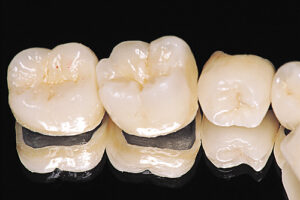
All-ceramic crowns
All-ceramic crowns are the highlight of today’s dentistry concerning aesthetics. The absence of metal makes the light refract just like in natural teeth. There is no metal refraction through the teeth or the appearance of a metal edge on the gum line, while the colour looks much more life-like and natural. These crowns are the therapy choice for people alergic to metal. All-ceramic crowns are very effective on the front teeth, both as a single crown or a part of a dental brigde.

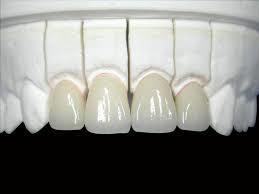
Zirconium dental crowns
Zirconium crowns are made of zirconium dioxide (ZrO2) which belongs to the group of highly durable ceramic materials, so they are recomendedfor both front and lateral teeth. The process of making zirconium crowns is very percise, so there is no additional fitting the crowns under the gums. All this lessens the iritation and makes the dental hygiene easier. Besides, there is no metal refraction or the appearence of metal edges.
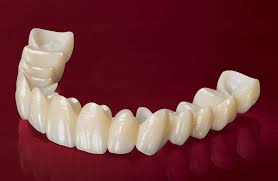
Bridges
A dental bridge is a dental restoration of at least two connected tooth crowns. In patients lacking one or more teeth, a dental bridge stabilizes the bite and prevents shifting and tilting of surrounding teeth into the empty space. It also prevents the loss of vertical dimension. Bridges are cemented and can not be removed from the mouth. The missing teeth are restored by lab-made crowns that are connected to at least two dental caps and cemented to the previously trimmed teeth. Bridges are used to restore a smaller or larger number of lost teeth, under the condition that there are stable and healthy teeth to carry the fixed bridge.
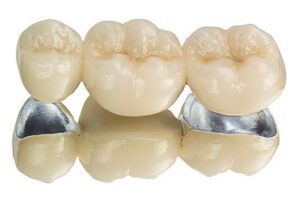
Prostheses
Skeletal prostheses
Skeletal prostheses include Vironit or Vizil prostheses (the names of the alloys which they are made of). These are highly reduced dentures with metal skeleton for the basis. These dentures almost completely physiologically transfer chewing pressure evenly and relying on the gums and teeth, thus practically preserving the remaining natural teeth and jawbone. Instead of using wire hooks, they are connected to the teeth with clasps or some other modern retention elements that give them a high aesthetic value. By proper preparation of the prostheses and restoration of the lost teeth, we can achieve rehabilitation of chewing, speech and swallowing as well as the aesthetic value.
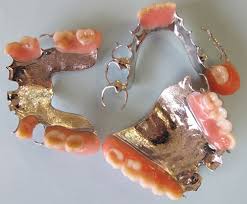
Acrylic prostheses
The oldest and longest used are certainly acrylic prostheses. They are used in patients who have lost all of the teeth or have a small number of remaining teeth. The main aim of using these prostheses is to restore the function of chewing and speech and also the aethetic appearence. Acrylic prostheses are mobile (movable) prostheses that can be removed from the mouth, which is one of their main flaw. The period of adjusting is much longer than with dental crowns and bridges, and at first, they can be unstable while chewing or speaking. Patients can easily accept these prostheses with the dentist`s support and persistant will.
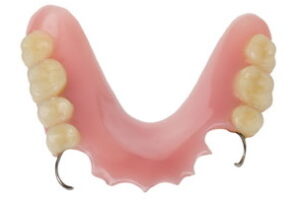
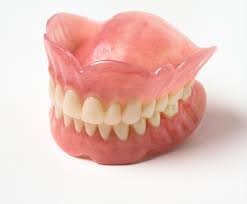
Flexible prostheses
Deflex, flexible prostheses are made of thermoplastic polyamide. They are polyrigid, semitransparent prostheses. Due to their flexibility, they are much easier to adjust to. They are resistant to damages caused by falling or impact. The hooks are transparent, which gives them better aethetic value. They don`t cause alergic reactions, they are comfortable and they don`t obstract speech. They can be combined with dental crowns and bridges.
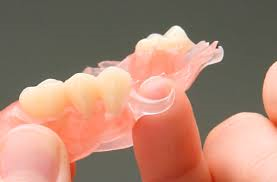
Make an appointment with our dentists
Form for FREE Consultation
